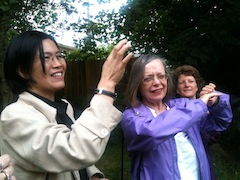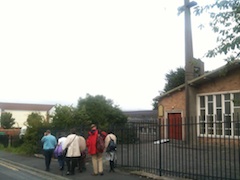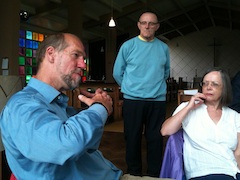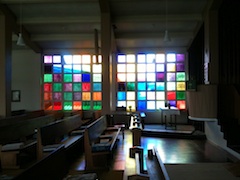Creating a sacred space in a deprived urban estate
August 15, 2012:
 |
 |
 |
Dr He (left) being shown around St Andrew's grounds by members of the congregation |
What happened when an expert in Chinese sacred landscapes met a traditional English Christian congregation?
A meeting between two very different traditions this week has produced an unexpected new perspective on a challenge facing an Anglican church - how to create a contemporary sense of the sacred in the heart of a deprived housing estate on the edge of a major city.
Like so many congregations in the UK, St Andrew's Church in Hartcliffe, Bristol, is facing multiple challenges, including an decaying church building, an ageing and diminishing congregation and the fact that it no longer has a resident vicar.
 |
 |
 |
St Andrew's Church which will be replaced by a new consecrated building and sacred space |
After decades as a thriving, lively church at the heart of the community, matters had degenerated to the point that the Church of England was seriously considering closing St Andrew completely.
But local people passionately did not want such a drastic move which would mean the Church was effectively withdrawing from Hartcliffe. When times are difficult, that’s when we need the Church most, they told officials.
And times are difficult for Hartcliffe, a large post-war estate built approximately five miles south of Bristol’s city centre. It’s a beautiful location, overlooked by Dundry Hill and with open countryside stretching towards Somerset, but it’s one of Bristol’s most deprived areas; jobs are scarce and incomes are among the lowest in the city.
 |
 |
 |
ARC's Martin Palmer discusses the project with St Andrew's members |
“Most people regard Hartcliffe as a bit of a lost cause,” says ARC Secretary General Martin Palmer, whose latest book, Sacred Land, has been winning high praise. That's not the only reason why he is involved in this project - he grew up in Hartcliffe where his father was vicar of St Andrew’s for many years.
Longing for a sacred spaceThe fact that so many people see Hartcliffe as a lost cause makes this project all the more exciting.
“How more radical could you be than to say that here will be the most radical interpretation of a sacred space? Because in the research we’ve done in the community, the longing for a sacred space is enormous.”
That longing was heard by the Church which, far from withdrawing from Hartcliffe, has agreed to embark upon a radical rethink of what a contemporary sacred space could be in this most urban of settings. St Andrew’s will get a new church building – but everything else in its surprisingly large grounds is up for grabs.
 |
 |
 |
The interior of St Andrew's |
As part of this radical rethink, ARC brought Dr He Xiaoxin, an expert in Chinese architecture and landscape – and in particular feng shui, the ancient Chinese system of geomancy used to balance the energies of any given space to ensure harmony, good fortune and health – to Hartcliffe this week.
“The idea is to bring someone from a very different tradition into the debate. Otherwise the danger is we’d get what we already have, with a funny bit out at the front,” explains Martin Palmer.
“So we are asking two architects – one Chinese, one Western – to consider: ‘What would I do to create a modern sense of the sacred here?’ and then we will draw up a brief for an international architecture competition.”
Different perspectiveAnd already Dr He has provided an entirely different perspective on Hartcliffe. Examining maps of the area and then walking around the space, she was instantly struck by the alignment of Dundry Hill and the streams that run off it – one of which runs through culverts under St Andrew’s land – which she said were particularly harmonious for Hartcliffe.
“In Chinese tradition we would call this a water mouse; a water mouse brings good luck to the city; it gives an auspicious blessing,” she said. “In China, we would build a tall building here and it would bring good luck to the settlement, to the city.”
Martin Palmer was excited to hear this. “We’re not used to Hartcliffe being thought of as bringing good luck to the city of Bristol. Already we’re getting a radical rethink of what Hartcliffe could be.”
Having spent a few hours looking at the area and talking to members of St Andrew’s congregation about what they want, Dr He will come up with her recommendations for creating a contemporary sacred space, something that will also be done by a Western architect before the final brief is drawn up.
This is just the first stage in what will be a five-year project that is being run as a joint venture between the Anglicans, Methodists and Catholics. “Hartcliffe will be the most radical experiment in completely reconceiving what it means to have a sacred space on an estate – a fusion between sacred space and nature,” says Martin Palmer.
We'll keep you updated as to the project's progress. You can also read an excellent Daily Telegraph article about the Sacred Land project here.
|

